
194
Chapter 3 Bar Codes
c. The length of the data field need not be
specified, since it is fixed at 6 or 11 digits, plus
any add-on data.
d. The information for the data field is entered
dynamically during the Execute Form mode.
(Refer to “Execute Form: Dynamic Bar Code
Data” on page 63.) Do not use the
data field
parameter to enter data when the BF
n
parameters are used. However, refer to the
data field
description for available characters.
DARK Optional parameter to produce darker bar codes.
Enter DARK. Refer to “Dark Printing” on page 28
for more information.
SR
Defines the starting row for the bar code. Enter a
value ranging from row 1 to one less than the
length of the form. Character row or dot row is
specified based on the Scale command (page 83),
or use the CP.DP format (page 26).
SC
Defines the starting column of the bar code. Enter a
value ranging from column 1 to one less than the
width of the form. Character column or dot column
is specified based on the Scale command (page
83), or use the CP.DP format (page 26).
(D)
The printable character (delimiter) identifying the
start and finish of the data field. Enter any printable
character other than a slash (/), the SFCC, or a
character used within the data. The same character
must be used at both ends of the data field but it will
not print with the data.
data field
The characters available for the data field are 0
through 9 (30 through 39 hex, respectively).
For UPC-E, eleven digits are expected: Enter the
number system character first by entering 0;
followed by the five-digit manufacturer number;
ending with the five-digit item number. The
manufacturing number and item number
sequences must conform to one of the number
pattern sequences shown in Table 18.
The IGP will compress the 11 characters of data
down to the six encoded UPC-E symbol characters.
Include the 2- or 5-digit add-on data at the end of
this data field.
For UPC-E0, six digits are expected. These six
digits must be a valid compressed UPC-E number.
Otherwise, Error 96 will be generated.


















